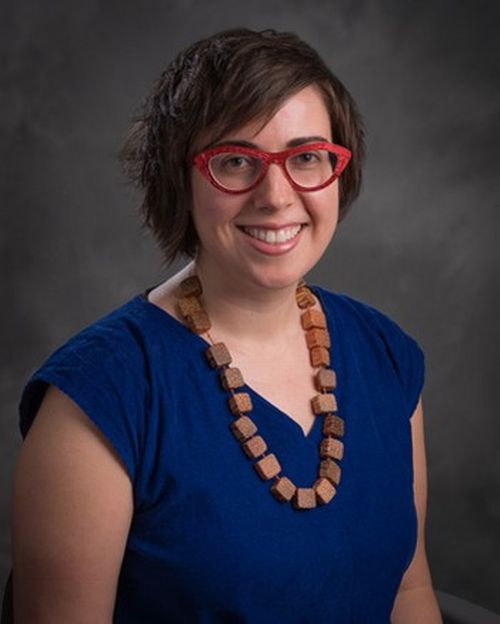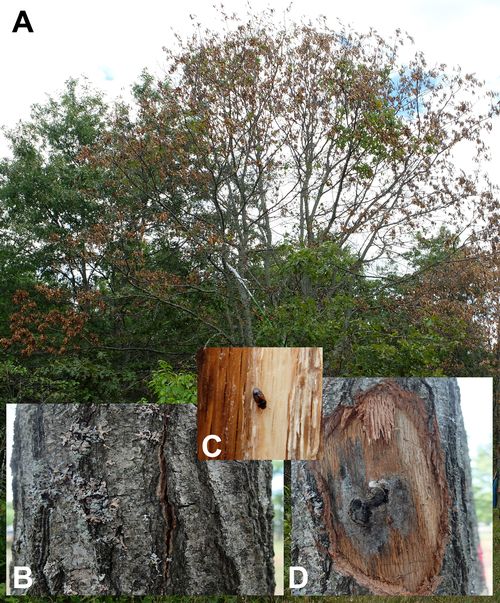Lab focuses on addressing emerging forest diseases
Work includes addressing oak wilt in Michigan

Michigan trees and the native and invasive diseases that attack them are at the center of research performed by Monique Sakalidis, MSU professor in the departments of Forestry and Plant, Soil and Microbial Sciences.

Her lab develops molecular tools that identify pathogens within a few hours, a process that could take weeks using traditional methods. She works closely with the plant and pest diagnostic labs at MSU and the Michigan Department of Agriculture and Rural Development (MDARD) to move these tools into application.
While she studies exotic pathogens, Sakalidis is also concerned with native pathogens that are becoming empowered by stress and climate change.
“Increasing human influences, including climate change, put stress on our forests so that pathogens -- that are part of the natural forest ecosystem where they nibble away at declining trees to help the decaying process -- start to nibble away at relatively healthy trees,” she said.
Through appointments in research, MSU Extension and teaching, she works alongside the DNR, MDARD and the U.S. Forest Service as they consistently survey forests and sites where trees and seedlings grow.
“I’m focused on treating the diseases faced by Michigan trees,” she said. “I work with issues that affect trees in forests across the state, small-holder forests, Christmas tree farms, seedling nurseries, urban trees and more recently chestnuts. My work really includes quite a broad purview.”
According to DNR Forest Health Specialist James Wieferich, Sakalidis has fast become an invaluable resource for her work on diseases including Heterobasidion root, oak wilt, Caliciopsis canker and beech leaf.
“Dr. Monique Sakalidis, as a fairly new professor, has already proven to be a great asset for the DNR to rely on to get some difficult questions answered regarding tree diseases that have been impacting Michigan Forests,” Wieferich said. “Research projects performed by Dr. Sakalidis’ lab have helped shed light on many forest health issues plaguing Michigan trees. Studies like these help the DNR better understand how the disease works, enabling us to exploit key lifecycle periods to better control, manage and/or eradicate certain forest health issues.”
Sakalidis has also partnered with fellow MSU Forestry researcher Deborah McCullough and the DNR to address the increasing incidence of oak wilt in Michigan.

A complex fungal disease transmitted both underground through root systems and above ground by a type of beetle that vectors the disease from dead oaks to living ones, oak wilt is causing mass mortality in healthy red oaks across the state.
“In hopes of understanding aboveground spread better, MSU professors took on the difficult task to evaluate different factors that play a role in disease spread,” Wieferich said. “With collaboration between the DNR and staff at MSU, including Dr. Sakalidis, MSU was able to focus on clear pieces of the pie like the insect vector, tree defense, and pathogen spore viability. This research will clearly state when aboveground spread is not possible and what time of year there is a high risk for infection.”
Upon identifying a challenging tree health issue without an easy management solution, she works with partners to diagnose the issue and develop a research plan.
“We have been working to develop better detection tools and understand the biology and spread of diseases such as oak wilt, Caliciopsis canker, Phytophthora root rot, and spruce decline here in Michigan,” she said. “These diseases impact trees and seedlings in Michigan, in the U.S. and in some cases globally.”
What happens when contacted about a potential new pathogen?
“We initially want to know what is it, where is it and what can we do about it,” she said. “The what is it is our ability to detect it, sometimes with our eyes, sometimes with a molecular tool. The where is it is that survey work where we tap into a network of people. And the what can we do about it is the big question mark.”
Sakalidis helps with advice and to find solutions.
“In the case of oak wilt, my lab works with Dr. Deb McCullough who is a forest entomologist and Dr. Bert Cregg, who is a tree physiologist, to come up with a recommendation,” she said. “We basically build the science together, each of us working in the areas of our expertise to make those recommendations.”
While recommendations are tailored to each pathogen, prevention is the first step.
“The best thing is vigilance – regularly scouting trees, growing practices designed to minimize plant stress and increase plant vigor, buying from quality nurseries, being aware of the environment around us and seeking answers when we’re not sure what’s going on,” she said.
Sakalidis said she finds her work very rewarding.
“It’s wonderful to understand more about the pathogens I work with, but also to be able to find solutions and make a difference in people’s lives -- that’s the best thing,” she said. “It’s exciting for me to be able to work at the intersection of fundamental and applied research.
“To determine what research is needed, I talk to the folks involved in tree care, tree health and tree growing industries, to find out how they are currently managing diseases, and to hear directly from them about their needs. This ensures I am finding solutions to tree disease issues that are having the greatest impact.
In addition to providing preventative advice, Sakalidis has constructed her lab to handle emergent issues as they arise.
“Part of what I'm trying to develop in my lab is a pipeline of information, so if there is something new, we have a series of steps we can take to quickly say, ‘hey, this is what it is and based on the characteristics of this disease we know what we can do next,’ or ‘we don’t yet have the answers, and this is the research that is needed to find a solution,’” she said.



 Print
Print Email
Email





